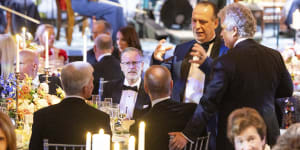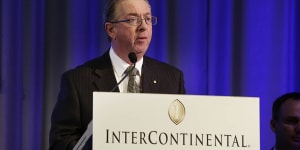Politicians are invited,alongside corporate titans,media bosses and journalists – including from theHerald and its owner,Nine. Issues are discussed and relationships forged. Their host,the man curating and conducting this ensemble of power,is Peter V’Landys,whose sway has become so great over almost 20 years as chief executive of Racing NSW and,more recently,as chair of the Australian Rugby League commission,that his influence in NSW is undisputed.
On Winx Stakes day in August,V’Landys and Australian Turf Club president Peter McGauran hosted a fundraiser in the Directors’ Room for a bereaved family close to many in Labor,which was attended by Premier Chris Minns. The racing boss and McGauran,his close friend,each chipped in $10,000 at auction to buy a statuette of the champion racehorse.
No stranger to the Directors’ Room is Russell Balding,the chair of Racing NSW and the only man to whom V’Landys is required to answer. They are a formidable team,and have more than doubled Racing NSW’s revenue since Balding took the helm in 2017. They have established the world’s richest turf race,drawn crowds back to the track and brashly muscled in on Victoria’s longstanding dominance.
As punters at Randwick enjoy the revitalisation of NSW racing in Randwick’s flashy new facilities,they could be forgiven for wondering why there would be any opposition,particularly from leading industry figures such as trainer Gai Waterhouse and Magic Millions co-owner Katie Page to the Minns government’s plan to keep Balding on the board and to protect his working relationship with V’Landys.

Racing NSW chief executive Peter V’landys at a White House dinner in October.Alex Ellinghausen
The answer lies in power,personalities and politics,and goes to the heart of how decisions are made in NSW.
Racing NSW’s power is immense and growing. Balding and V’landys are tight. If rules about tenure on public sector boards designed to prevent groupthink had been followed,the chair – whose job is to rein in as well as support the chief executive – would have left four years ago. Instead,parliament has extended his term twice. The Labor government signalled he would go when it expires again in December. Then,amid strong lobbying from sections of the industry,it changed its mind. Balding will now serve a record 14 years as director.
Critics accuse the government of betraying principle in the face of racing’s power. “Minns was about transparency,” says one senior racing figure on the condition of anonymity because he was not authorised to speak publicly. “No jobs for the boys,proper boards. And then this.”
Racing NSW was set up by parliament in the mid-1990s to run and regulate the state’s racing industry,which had long been mired in scandal and corruption. It is required to act in the public interest,as well as that of racing.
Its jurisdiction stretches from its feared stewards,who can demand a phone without a warrant – “they are more powerful than police,” one senior industry figure said – to trainers,jockeys and bookmakers,who it licences and regulates. It decides how funding and race dates are distributed to clubs,makes key decisions about the direction and future of the industry,and handles an income of almost $400 million a year.

In the last decade,its power has grown exponentially. The turning point was a deal,engineered by V’Landys,to keep directing revenue from the TAB to clubs and to give Racing NSW a cut from corporate bookmaking. As punters abandoned shopfronts for online gambling,the once-mighty clubs got poorer and Racing NSW got richer. The balance of power shifted quickly and emphatically. With less money for prizes and upkeep,clubs needed handouts. The regulator became the industry’s biggest funder. Balding and V’Landys,racing’s professional power couple,sit at the apex of it all.
V’Landys doesn’t agree with that assessment. “I am not as powerful as everyone thinks as there are not many phone boxes in Sydney these days so its hard to change into my Superman uniform,” he says.
The act that established Racing NSW protects it from political meddling;it’s not even subject to the state’s corruption watchdog. The government’s only influence is the appointment of new board members,chosen from a list of names picked by an independent panel. Racing Minister David Harris,who has been in the job since Labor won government in March,could have chosen two new directors this year and thought about doing it. Instead,he will ask parliament to change the act to give Balding and his deputy chair two more years. He had his hand on a lever that would shift the dynamics at the top of Racing NSW,but decided not to pull it.
It’s the third such decision. The Coalition made it twice. Two years ago,the selection panel had begun interviewing candidates when the government asked parliament to keep Balding. A former minister,speaking on the condition of anonymity to respect confidential discussions,said there was “discomfort” among some in cabinet – 12 years is an unusually long tenure for a board director,especially in the public sector,and particularly when the legislation must be changed to allow it – but the driver was practicality. The state was emerging from a COVID-19 lockdown. They’d just lost a premier to a corruption scandal. There were bigger problems.

Russell Balding is seeking two more years at the top of Racing NSW.Jessica Hromas
This year,advocates of change had their hopes up. Their gripes with the board were numerous,beginning with its vintage and gender. The average age of non-executive directors is 68,and there is only one woman. V’Landys points out that boards should be skills-based – pointing to age is “discriminatory and condescending” – and says his staff is diverse in terms of age and gender. “In my time at Racing NSW,the results highlight that this is by far the most successful board,” he says.
Some were also upset by the board’s decision to allow V’Landys to chair the NRL in 2019,arguing that working for a rival sport competing for a slice of the same wagering revenue could be a conflict of interest. Again,V’Landys disagrees. “Fortunately,both thoroughbred racing in NSW and rugby league in Australia are flourishing,” he says. “Both are in the best financial position in their history and the success of both undermines any suggestion as to a conflict.”
There was frustration about Racing NSW’s court battle with other states over anti-competitive behaviour,based on what it suspects was a Victorian-led plot to exclude it from the thoroughbred industry and form a breakaway group from Racing Australia. Balding is seen as the driver of that court action,which some – including the breeders association – feel has paralysed the industry at a national level.
They also felt Racing NSW had not been transparent enough on animal welfare,which is key to the industry’s future as without it,the sport’s so-called social licence would be revoked by the non-racing community. (V’Landys says it is the “world leader in equine welfare initiatives”.) They believed it had neglected to develop an emerging workforce,and had let infrastructure such as stabling deteriorate. All these issues were raised by Harris as industry challenges when he announced on Monday that he would reappoint Balding.
In response,V’Landys pointed theHerald to the. He says it “confirms the agendas are being driven by self-interest and to assist failing interstate jurisdictions”.
There’s criticism of Racing NSW’s prize money strategy,too:that too much money is going to big events such as The Everest and the $3 million Big Dance,which former Racing NSW chair John Messara describes as “wasteful gimmick races”,at the expense of smaller country ones. V’Landys vehemently disagrees. “The Everest is the most wagered race after the Melbourne Cup in Australia,” he says. “Industries that live in the past normally perish.”
Some also felt Racing NSW had begun to throw its weight around. Multiple senior racing figures told theHerald they believed Balding and V’Landys were too close after six years as a team,and Racing NSW needed a fresh set of eyes on its powerful CEO.

The Everest Carnival has been a huge success in Sydney.Dion Georgopolous
But Balding’s supporters – some of whom also refused to go on the record – argued NSW racing was in rude health under the double act,pointing to record prize money,a rich balance sheet and strong influence. Much of the money now flowing into NSW racing was the result of reforms or decisions for which V’Landys,latterly with Balding,was responsible. They saw no reason to mess with a winning formula. “It’s been the reinvigoration of racing in NSW,” said Newhaven Park breeder John Kelly.
In late July,four powerful industry figures met Premier Chris Minns. Among them were former Racing NSW chair John Messara,and Magic Millions co-owner and Harvey Norman chief executive Katie Page. They argued for a change at the top of Racing NSW,and sources within the meeting – speaking anonymously to protect confidential discussions – said they left under the impression that Balding would be replaced.
Minns even asked Page whether she would be interested in the chair’s job,the sources said. She was not,but if she had been,one attendee said,“this debate would not be happening now.” When theHerald put the suggestion to Page,she said:“I get offered quite a few board positions and I don’t disclose what I’m offered or I decline.”
Another senior racing industry figure,speaking anonymously because he did not have permission to speak to the media,said a member of Racing Minister Harris’ office told him in early September that the chair’s term would end at the end of the year.
But by late September,Balding’s supporters had swung into action. A collection of stakeholders including jockeys and trainers,who are regulated by Racing NSW,and race clubs,who increasingly depend on it financially,wrote to Harris asking for his tenure to be extended by 12 months,arguing the industry needed stability.
Balding repeatedly declined invitations to comment on his reappointment. But a letter he sent to the chair of Aushorse Marketing,demanding to know if the company’s chief executive Tom Reilly had spoken toThe Guardian for a series of racing stories,shows it was on his mind. “Has your chief executive made representations or sought meetings with the NSW government as recently as in the last two weeks on the matters whichTheGuardian are enquiring,namely but not limited to the tenure of Mr V’Landys and myself?” he asks in a letter dated October 2023.
Harris told a parliamentary estimates hearing that no Racing NSW executives lobbied him to reappoint Balding. But V’Landy’s view of his chair’s tenure is made clear by the fact that some of his closest allies outside the regulator did. They included the ATC’s McGauran – a Howard era cabinet minister and godfather to V’Landy’s son – and Richard Callendar,the NSW Trainers Association chief executive,who both wrote letters of support. In both cases,directors were told about the letters only after they had been sent,multiple sources said on the condition of anonymity to preserve confidentiality. McGuaran told theHerald he’d told his directors about the letter and “there was no objection”.
McGauran is upfront about his support. Balding – who has been managing director of the ABC,chief executive of Sydney Airport,and chair of Cabcharge – has “done a magnificent job as chairman”,he told theHerald. “In the corporate world,shareholders would be clamouring to retain such a successful chair and board.”
When asked whether he backed Balding’s reappointment,V’Landys said it would be inappropriate for him to comment. “However,I reject your notion Russell doesn’t have universal support,” he said,adding that six of seven participant groups “petitioned the minister to extend Russell’s term”. The missing group was Thoroughbred Breeders NSW,whose members are not subject to regulation by Racing NSW. It had a very different view.
Its president,Hamish Esplin,wrote to Harris in late September saying the organisation felt it had little choice but to “express our strong view that the current Labor government not acquiesce to the demands of the few by extending the director’s term to 14 years”,citing the government’s rules for board tenure (no more than six years for state-owned corporations,to avoid groupthink),Balding’s lacklustre attendance at consultative group meetings,and Racing NSW’s legal action.
Esplin also wrote he had been approached by a senior administrator to support the extension of the director’s term “‘as a favour’ …[which] says everything about those wanting to keep the status quo and nothing about the future”.
To reappoint Balding,Labor’s amendment to the act must pass parliament before his position becomes vacant in late December.
Opposition Leader Mark Speakman has refused to say whether it will have Coalition support until it sees the legislation next week. On Wednesday,Minns on Thursday backed Harris’ decision,while distancing himself from it.
For V’Landys,Racing NSW’s detractors merely highlight its success. “It highlights that in racing,self-interest is still king,” he says. “The NSW racing industry has never been in a better position,however,groups acting in self-interest or assisting failing interstate jurisdictions wish to bring it down.”
Start the day with a summary of the day’s most important and interesting stories,analysis and insights..